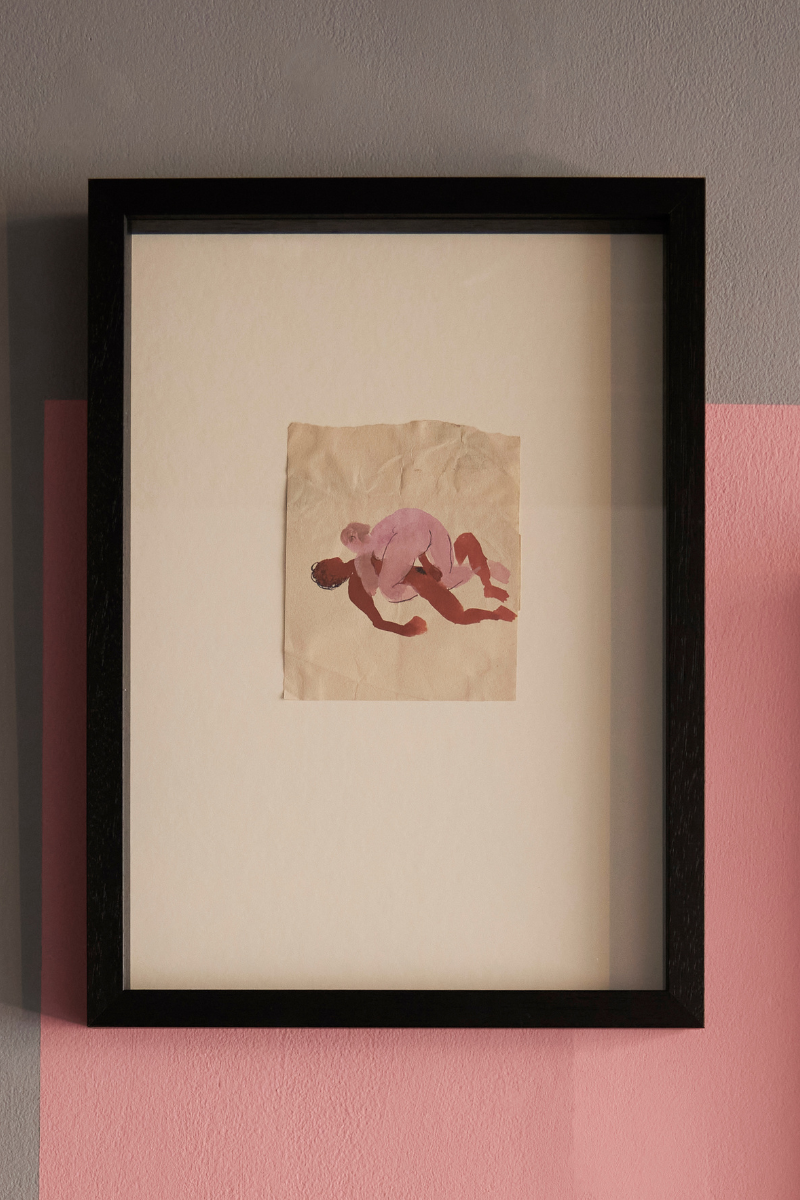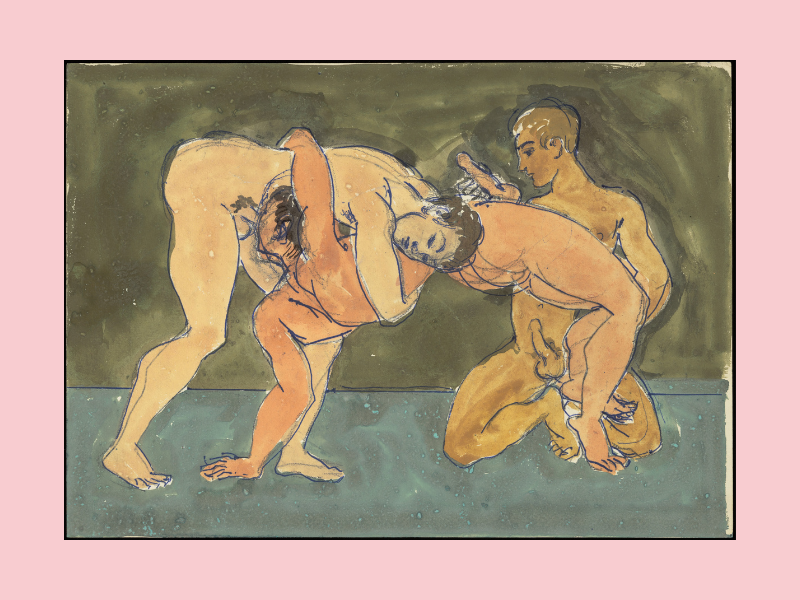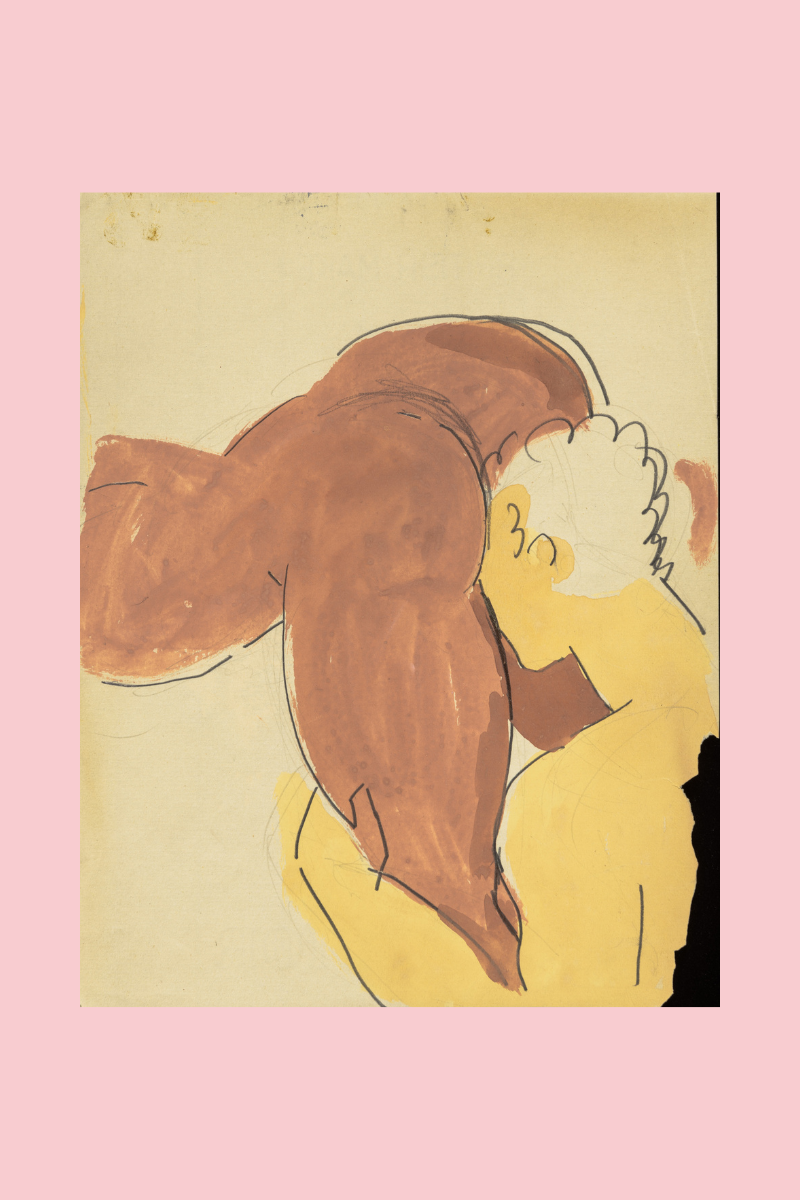“Private” Parts!?
16 September 2022 — 23 December 2022
In a collaboration with Charleston, “Private” Parts!? is the London debut of Duncan Grant’s ‘lost’ erotic drawings. Contextualised by the artists Jakob Lena Knebl and Ashley Hans Scheirl, the exhibition not only celebrates Grant’s artistic lineage but acts as a site to consider notions of censorship, lust, and erotic sensibility.

Installation View
Drawn by Duncan Grant during the 1940s and 50s, when sex between men was still illegal in England (and any notion of sexual deviance was frowned upon), these historic drawings depict intimate scenes of love, lovers, and acts of lovemaking that deviated from rigid standards of conservative normalcy. Feared to have been destroyed, due to their ‘controversial’ subject matter, the drawings resurfaced in 2020 after being donated to Grant’s former home, Charleston Farmhouse in Sussex.
As a continuation of their collaborative practice, “Private” Parts!? is Jakob Lena Knebl and Ashley Hans Scheirl’s first duo exhibition in the UK. Set within a minimal installation, conceived by Knebl, here, a selection of Grant’s sensitive scenes will be paired with archival drawings made by Scheirl in the late 1980s and ’90s. in this way “Private” Parts!? is envisaged as a trans-generational conversation; a dialogue about acts of censorship, modes of loving, as well as erotic sensibility and differing ideas of desire.
Though differing in aesthetic sensibility, both Grant and Scheirl’s loose sketches revolve around ideas of erotic longing; the freedom found in the caress of a lover, lovers, and indeed the act of loving. Departing from their usual artistic strategy of excess, Knebl & Scheirl, as an artistic couple, have developed the ideas for this exhibition by sitting with the material sensuality innate to Grant’s ‘lost’ drawings. Echoing the subtle beauty of these works, the private dialogues writhing beneath the surfaces of both Grant and Scheirl’s sketches emerge here as notes that pass between lovers; indeed, as visual quotes, lovingly reaped from private diaries, as gestures only ever meant for the eyes of those held dear.

Installation View
Duncan Grant, Untitled Drawing, 1946-1959
gouache and pencil on paper, 35.5 x 25.5 cm
Duncan Grant, Untitled Drawing, 1946-1959
gouache and pencil on paper, 23 x 33 cm
Duncan Grant, Untitled Drawing, 1946-1959
gouache and pencil on paper, 45 x 29 cm
Duncan Grant, Untitled Drawing, 1946-1959
gouache and pencil on paper, 31 x 45 cm

Installation View
Duncan Grant, Untitled Drawing, 1946-1959
gouache and pencil on paper, 41.5 x 29 cm
Duncan Grant, Untitled Drawing, 1946-1959
gouache and pencil on paper, 26 x 21.3 cm
Duncan Grant, Untitled Drawing, 1946-1959
pen on paper, 31 x 23.5 cm
Duncan Grant, Untitled Drawing, 1946-1959
gouache and pencil on paper, 31 x 23.5 cm
Duncan Grant, Untitled Drawing, 1946-1959
gouache and pencil on paper, 23.5 x 19.6 cm
Duncan Grant, Untitled Drawing, 1946-1959
gouache and pencil on paper, 20.2 x 13 cm
For images of the drawings by Ashley Hans Scheirl included in the exhibition please contact the gallery.
Further context for the exhibtion
Jakob Lena Knebl’s (1970-date) and Ashley Hans Scheirl’s (1956-date) practices revolve around what they call ‘trans-…’ processes: transmedium, transmateriality, transgenre, transcontext, transidentity. Whether proceeding from cultural materials – high to low – or taking flight from binary notions of identity and selfhood, both artists share a common belief in the possibilities afforded through anomalous juxtaposition. Partners in life and art, each artist has their own distinct practice but come together to work on projects as companions, seeing this multiplicity as a more capacious method through which to confound notions of identity, sexuality, and the sociopolitical forces mediating humanly becoming. For their first UK exhibition as a duo, “Private” Parts!? (Belmacz), the pair enter into a trans-generational conversation with Duncan Grant (1885-1978). Working with the material sensitivities and sensuality eeping from Grant’s erotic drawings, the pair break with their usual aesthetic of excess to subtly complicate ideas of sexual freedom.
Knebl’s practice expands from staged photography to immersive mise-en-scène. Across this output, the histories of art and design collide with a theatrical androgeny – think Ziggy Stardust. These scenes of shadowed vivacity challenge viewers to consider how desire operates upon bodies. With a background studying fashion and textual sculpture, Knebl’s practice weaves together different historical moments, differing art and/or craft forms, materials, as well as attitudes together to produce ‘spaces of desire’ – locations where taxonomic thinking is blurred through voyeuristic delight – that allow new ways of thinking to emerge. An example of this collapsing of times, life and art can be seen in Knebl’s 2017 exhibition Oh… Jakob Lena Knebl at the mumok Collection. Here she conceived a bold rearrangement of the Museum Moderner Kunst Stiftung Ludwig Wien’s collection; specifically, their classical modernist and 1970s collections – two periods of renewed utopian expression. Appearing as an avatar, here Knebl placed herself beside the numerable other objects – now protagonists – within the installation; in doing so, aiming to democratise the exhibition space by opening an inquiry into how the topics, things, places, people and contexts that surround become co-creators of our identities.
In the late 1970s, Ashley Hans Scheirl completed their studies in Vienna before spending some 20 years travelling between New York – where they were deeply engaged in the underground performance scene – London as well as other cities. Between 1979 and 1998 they produced over 50 short films, as well as their acclaimed feature Dandy Dust (1998). Appearing as some kind of Artificial Hell (to riff off André Breton), Dandy Dust works with a particularly raucous visual language to narrate its fluid gender cyborg protagonist’s journey across time and space. Working at the fringes of media, Scheirl’s practice radically challenges norms of sexuality, gender identity as well as medium specificity itself. The post-human sensuality, developed in Scheirl filmic work, has more recently been used to corrupt the formalities of painting. Scheirl’s conceptual paintings abound with surreal energy; bringing print and people, architecture and objects together in a pointed critique of contemporary world systems. Scheirl’s presentation at documenta 14, 2017, provides a pertinent example of how their dissonant bricolages unsettle fixed systems; specifically, how sexuality becomes an optimizable commodity under neoliberal economics.
Together, Knebl and Scheirl have established a practice of fabulous excess. Their installation-based works deploy a process akin to parataxis to allow numerable fragments, details from histories and/or parts of larger bodies, to sit in proximity to one another without subordination. Often accentuated, indeed activated, by bombastic colour and their own bodily presence, the inter-subjective narratives emerging from their theatrical stages rupture binary world views, of public and private life, creating a place where one can begin to re-conceive a social self. Invitation of the Soft Machine and Her Angry Body Parts, Knebl and Scheirl’s installation at the Austrian pavilion for the 59th Venice Biennale, embraces this practice of overabundance to establish a place “outside of all places” (to quote Micheal Foucault [Of Other Spaces]); one where the pair’s trans operations allow us to experience the thin line between ideas of the real and the fantastic. In doing so, they expose the common-sense fallacy that insists on singular notions of gender and identity.
Sitting with the sensual caresses sketched by Duncan Grant in his erotic drawings, “Private” Parts!?, foregrounds the intimacy of raw sexual expression; specifically, the freedom found in erotic desire as it is given visual form and passed to another. In this way, the exhibition can be seen as a transgenerational, transnational, conversation about erotics, sexual expression, as well as alluding to how bodily acts of desire become censored by sociopolitical norms. Instead of juxtaposing or using Grant’s works as part of a larger immersive narrative, this exhibition situates Scheirl’s ‘ob_scene drawings’ from the late 1980s and early 1990s in proximity to Grant’s own. Created at a time when Scheirl was discovering the queer clubs of London, the drawings translate the grainy materiality of their filmic work into more inward expressions of sexual delight and liberation. Held by a rhizomatic wall painting, in keeping with Knebl’s practice of creating affective mise-en-scène, the private dialogues writhing beneath the painterly surfaces of both Grant and Scheirl’s drawings flourish, passing between one another like quotes lovingly reaped from private diaries or letters sketched for a lover.
¬ text by Toby Üpson, published in Charleston Press 7, September 2022.
Artist biographies
Duncan Grant (1885 – 1978) was born Rothiemurchus, Inverness in Scotland. His childhood was spent in India, he returned to Britain in 1893. His parents had hoped he would follow his father into the army, but instead he took up painting at the encouragement of the French painter, Simon Bussy. Grant enrolled at the Westminster School of Art. He was a frequent visitor to France, meeting Matisse in 1909 and later Picasso. Back in London he established a studio in Fitzroy Square. He became a central figure in the Bloomsbury circle of artists and writers, centred around the home of Vanessa and Clive Bell. The group included Grant’s cousin Lytton Strachey, the economist Maynard Keynes, Roger Fry and Virginia and Leonard Woolf. Virginia was the sister of Vanessa Bell who became Grant’s life-long companion. For a time they both worked at the Omega Workshops founded in 1913 by the two artists with Roger Fry. The workshops produced furniture, textiles and pottery designed by various young artists including Bell and Grant. In 1916 Grant and Bell moved to Charleston, near Firle in Sussex. The house had been purchased by Maynard Keynes so that Grant, as a committed pacifist, could discharge his national service obligations by agricultural work during World War I. Charleston was embellished with decorations by both Grant and Bell, and they carried out other commissions, including the decorations for the church at Berwick, near Firle.
Jakob Lena Knebl (b. 1970, Baden, Austria), studied Fashion under Raf Simons at the University of Applied Arts Vienna and Textual Sculpture under Heimo Zobernig at the Academy of Fine Arts Vienna, graduating in 2006. Playing with the languages of fashion and art history, notions of identity and desire, Jakob Lena Knebl uses spatial and photographic intervention (juxtaposition and mise-en-scène) to (de-/re-)construct ideas of identity as well as ones relation to objects and spaces of cultural memory.
Ashley Hans Scheirl (b. 1956, Salzburg, Austria), studied art restoration at the Academy of Fine Arts in Vienna finishing with a diploma in 1980. From 1978 to 1985 they took part in the performative music experiments with the groups ‘8 oder 9’ and the female formation ‘Ungünstige Vorzeichen’. 1981-82 Scheirl lived in New York, working as assistant to Arleen Schloss, who staged the weekly performance evening ‘Wednesdays at A’s’. Between 1979 and 1996 over 50 short films were produced often in collaboration with intimate partners. Ashley Hans – formerly ‘Angela’ – became internationally known for their feature-length transmedia, transgenre, transgender film ‘Dandy Dust’ from 1998, which radically challenges norms of sexuality and gender identity as well as the medium cinema itself.
Though each has their own respective practice Knebl & Scheirl come together to work on projects as companions, seeing this multiplicity as a more capacious method through which to confound notions of identity, sexuality, and the sociopolitical forces mediating humanly becoming.

Jakob Lena Knebl, "Private" Parts!? Wall Design, 2022
digital render











